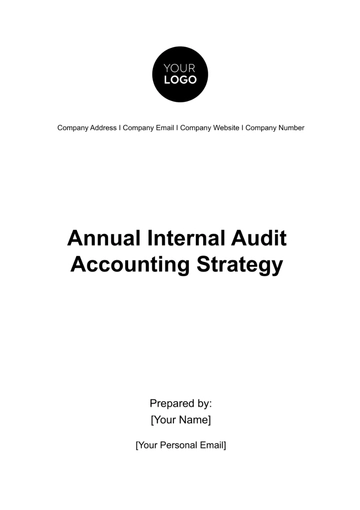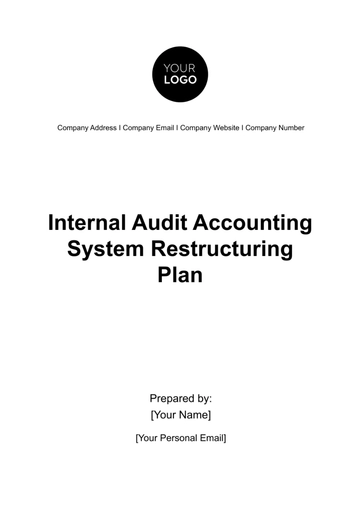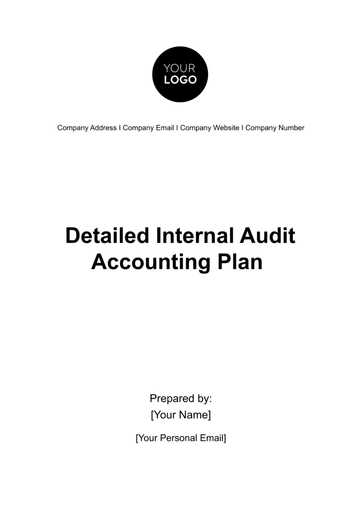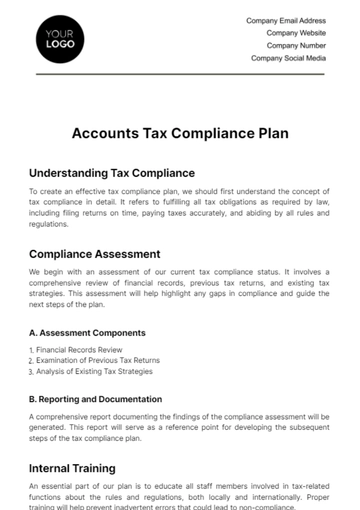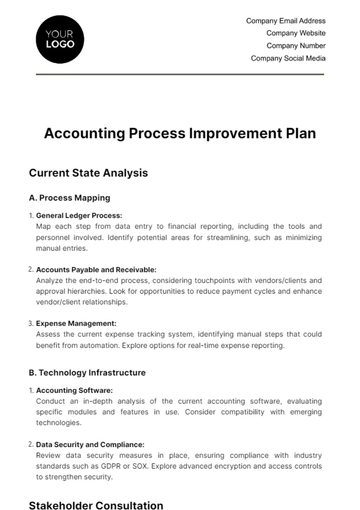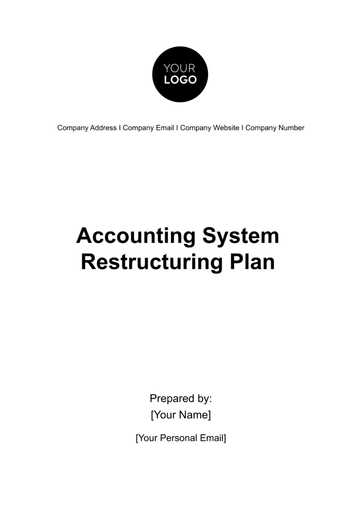Free Long-Term Accounting Asset Strategy Plan

I. Executive Summary
This Long-Term Accounting Asset Strategy Plan is designed to guide [Your Company Name] through the strategic management of its assets over the next decade. The primary objectives are to optimize asset utilization, ensure alignment with our broader strategic goals, and enhance financial sustainability. Key strategies include modernizing our asset inventory, implementing advanced risk management practices, and adopting cutting-edge technology solutions to improve asset tracking and performance analysis. Expected outcomes include improved asset utilization rates, reduced operational costs, and enhanced compliance with financial regulations, contributing to our organization's growth and profitability.
II. Introduction
The Long-Term Accounting Asset Strategy Plan outlines [Your Company Name]'s approach to managing its assets from acquisition through disposal. Given the rapidly evolving market conditions and technological advancements, a strategic approach to asset management is crucial for maintaining competitiveness and financial stability.
This plan is thus conceived as a living document, one that will evolve in response to internal and external changes, ensuring that our asset management practices continue to align with our broader business goals and the ever-changing landscape in which we operate. Through this plan, we commit to a systematic, informed, and proactive approach to asset management, laying a solid foundation for the financial health and operational excellence of [Your Company Name].
III. Strategic Context
[Your Company Name] operates in a dynamic industry where technological advancements and market demands evolve continuously. Our mission to deliver unparalleled value to our customers requires an asset base that is not only modern and efficient but also flexible enough to adapt to future needs. The strategic context of our asset management plan is aligned with our mission, vision, and long-term business objectives, aiming to ensure that our assets fully support these goals.
Market and Industry Trends
Technological Advancements: Rapid innovation in technology affects the lifespan and utility of our assets.
Regulatory Changes: Evolving compliance requirements necessitate proactive asset management strategies.
Economic Fluctuations: Market volatility impacts the valuation and financial management of assets.
Understanding these trends is critical for developing a resilient asset strategy that can navigate future challenges.
IV. Asset Management Objectives
The cornerstone of our Long-Term Accounting Asset Strategy is the establishment of clear, measurable objectives that align with [Your Company Name]'s overarching strategic goals. Beyond optimization, alignment, and financial sustainability, our objectives delve into enhancing asset lifecycle management, improving the accuracy of asset valuation, and fostering a culture of continuous improvement within our asset management processes. These objectives serve not only as a compass guiding our strategic asset decisions but also as benchmarks against which we can measure our progress and performance over time.
To ensure these objectives are met, we will implement a robust framework for asset management that includes regular training for our staff, adoption of best practices in asset maintenance and disposal, and strategic investments in technology that improve our asset tracking and management capabilities. By doing so, we aim to not only meet our current asset management needs but also anticipate and adapt to future challenges and opportunities, thereby securing the long-term viability and growth of our company.
V. Asset Inventory and Analysis
A thorough inventory and analysis of our current assets form the foundation of our strategy. This includes a detailed classification of assets into categories such as fixed assets, intangible assets, and financial instruments. Each asset is evaluated for performance, utilization, and alignment with our strategic goals. Underutilized or obsolete assets are identified for reallocation or disposal.
Example Asset Inventory Table
Description | Category | Acquisition Date | Cost | Utilization Rate |
|---|---|---|---|---|
Manufacturing Equipment | Fixed | [Date] | $500K | 75% |
[Description] | [Asset Category] | [Date] | [Amount] | [Percentage] |
VI. Risk Management and Compliance
Risk management is integral to our asset strategy. We assess financial, operational, and compliance risks associated with our assets, developing mitigation strategies for each. Compliance with regulatory requirements is non-negotiable; thus, our plan includes regular audits and updates to our asset management practices to ensure adherence.
Risk Mitigation Strategies
Insurance Coverage: Adequate insurance for high-value assets.
Regular Maintenance: Scheduled maintenance to prevent asset degradation.
Compliance Training: Ongoing training for staff on regulatory changes affecting asset management.
VII. Investment and Disposal Plan
Our Investment and Disposal Plan is a critical component of the Long-Term Accounting Asset Strategy Plan, designed to ensure [Your Company Name] remains agile and responsive to market changes while optimizing the value of our asset portfolio. The plan outlines a strategic approach to acquiring new assets that are essential for our growth and innovation, while also identifying assets that no longer contribute to our strategic objectives for disposal or reallocation. This dynamic approach to managing our asset portfolio ensures that our resources are always aligned with our highest priorities and that we are positioned to capitalize on new opportunities as they arise.
In implementing this plan, we will establish a cross-functional committee to oversee the evaluation of new asset acquisition proposals and the disposition of existing assets. This committee will utilize a comprehensive set of criteria, including strategic relevance, financial performance, and environmental impact, to guide its decisions. By taking a holistic view of each asset's contribution to our company, we can make informed decisions that support our long-term strategic objectives, ensure financial health, and uphold our commitment to corporate social responsibility.
VIII. Financing and Budgeting
The Financing and Budgeting section of our strategy underscores the importance of prudent financial management in sustaining our long-term asset objectives. It details the approach for securing the necessary capital for new investments, maintaining existing assets, and ensuring that all expenditures deliver optimal value for the organization. This involves a careful analysis of financing options, including leasing, debt financing, and the use of reserves, to determine the most cost-effective and strategic methods for funding our asset needs.
Moreover, our budgeting process is designed to be both rigorous and flexible, allowing us to adapt to changing financial conditions and strategic priorities. By incorporating scenario planning and sensitivity analysis, we can better anticipate future financial needs and allocate resources in a manner that supports our strategic goals while maintaining financial stability. This forward-looking approach to financing and budgeting is essential for managing the uncertainties inherent in long-term planning and ensuring that our asset management strategies remain viable over time.
IX. Asset Maintenance and Improvement Plan
The Asset Maintenance and Improvement Plan is vital for extending the lifespan of our assets and enhancing their performance. A systematic approach to scheduled maintenance not only prevents costly breakdowns but also ensures that our assets remain in optimal condition, contributing to their efficiency and reliability. This plan encompasses regular assessments to identify maintenance needs and schedules them in a way that minimizes disruption to our operations.
In addition to maintenance, we continuously seek opportunities for improving and modernizing our assets. This may involve retrofitting older equipment with new technology or implementing process improvements that increase asset utility.
Such improvements are evaluated not only for their potential to enhance performance but also for their ability to contribute to our sustainability goals, such as reducing energy consumption or waste. Through this proactive approach to maintenance and improvement, we aim to achieve a balance between operational excellence and environmental stewardship.
X. Technology and Information Systems
Adopting and integrating advanced technology and information systems is crucial for the effective management of our assets. The deployment of an Asset Management Information System (AMIS) will serve as the backbone for our strategy, providing a centralized platform for tracking, managing, and analyzing our assets throughout their lifecycle. This technology will enable real-time visibility into asset performance, maintenance schedules, and valuation, facilitating informed decision-making and strategic planning.
The integration of AMIS with our existing Enterprise Resource Planning (ERP) system ensures seamless communication and data sharing across departments, enhancing operational efficiency and reducing the risk of data silos. By leveraging cutting-edge technology, we aim to not only streamline our asset management processes but also to harness data analytics for predictive maintenance, asset optimization, and strategic forecasting, thereby driving continuous improvement and innovation in our asset management practices.
XI. Performance Monitoring and Review
Ongoing monitoring and periodic review of asset performance are critical for ensuring the effectiveness of our Long-Term Accounting Asset Strategy Plan. By establishing clear KPIs and utilizing advanced analytics, we can track our progress in real-time, identify areas for improvement, and adjust our strategies as needed to meet our objectives. This dynamic approach to performance management encourages a culture of accountability and continuous improvement, enabling us to respond quickly to changing conditions and maintain alignment with our strategic goals.
Regular reviews of our asset management practices, conducted by both internal teams and external auditors, provide an additional layer of oversight, ensuring that we adhere to the highest standards of compliance and best practices. These reviews also offer valuable insights into emerging trends and best practices in asset management, allowing us to refine and evolve our strategies to stay ahead of the curve.
XII. Implementation Timeline
Our Implementation Timeline outlines a phased approach to rolling out the various components of our asset strategy, ensuring that each phase is manageable and aligned with our overall strategic objectives. The timeline identifies key milestones and deliverables for each phase, providing a clear roadmap for execution and enabling us to track our progress. By breaking down the implementation into discrete, actionable steps, we can maintain focus and momentum, while also allowing for flexibility to adjust our plans in response to new information or changing circumstances.
Implementation Timeline Summary
Phase | Key Activities | Timeline | Responsible Department |
|---|---|---|---|
1 | - Asset Inventory Update - AMIS Requirements Assessment | [Quarter][Year] | Finance and IT |
2 | - AMIS Selection & Procurement - Policy Revision & Training | [Quarter][Year] | IT & HR |
3 | - AMIS Implementation & Integration - Maintenance Program Launch | [Quarter][Year] | IT & Operations |
4 | - Performance Monitoring Setup - Investment Strategy Review | [Quarter][Year] | Finance & IT |
5 | - Strategy Review & Adjustments | [Quarter][Year] | Executive Board |
XIII. Conclusion
In conclusion, the Long-Term Accounting Asset Strategy Plan for [Your Company Name] represents a comprehensive and strategic approach to managing our assets in a way that supports our long-term objectives, enhances our financial sustainability, and positions us for future growth. By focusing on optimization, compliance, and innovation, we are confident that this plan will not only improve our asset management practices but also contribute to our overall success. We are committed to executing this plan with diligence and foresight, ensuring that [Your Company Name] remains at the forefront of our industry for years to come.
XIV. Appendices
Detailed Asset Inventory List
Methodology for Asset Valuation
KPI Definition and Calculation Methods
- 100% Customizable, free editor
- Access 1 Million+ Templates, photo’s & graphics
- Download or share as a template
- Click and replace photos, graphics, text, backgrounds
- Resize, crop, AI write & more
- Access advanced editor
The Long-Term Accounting Asset Strategy Plan Template from Template.net is a professionally designed blueprint for shaping your organization's future asset management. This editable and customizable template guides the strategic planning process, ensuring a comprehensive approach to asset optimization and financial planning. Ideal for finance professionals who can now edit the template using an Ai Editor Tool.
You may also like
- Finance Plan
- Construction Plan
- Sales Plan
- Development Plan
- Career Plan
- Budget Plan
- HR Plan
- Education Plan
- Transition Plan
- Work Plan
- Training Plan
- Communication Plan
- Operation Plan
- Health And Safety Plan
- Strategy Plan
- Professional Development Plan
- Advertising Plan
- Risk Management Plan
- Restaurant Plan
- School Plan
- Nursing Home Patient Care Plan
- Nursing Care Plan
- Plan Event
- Startup Plan
- Social Media Plan
- Staffing Plan
- Annual Plan
- Content Plan
- Payment Plan
- Implementation Plan
- Hotel Plan
- Workout Plan
- Accounting Plan
- Campaign Plan
- Essay Plan
- 30 60 90 Day Plan
- Research Plan
- Recruitment Plan
- 90 Day Plan
- Quarterly Plan
- Emergency Plan
- 5 Year Plan
- Gym Plan
- Personal Plan
- IT and Software Plan
- Treatment Plan
- Real Estate Plan
- Law Firm Plan
- Healthcare Plan
- Improvement Plan
- Media Plan
- 5 Year Business Plan
- Learning Plan
- Marketing Campaign Plan
- Travel Agency Plan
- Cleaning Services Plan
- Interior Design Plan
- Performance Plan
- PR Plan
- Birth Plan
- Life Plan
- SEO Plan
- Disaster Recovery Plan
- Continuity Plan
- Launch Plan
- Legal Plan
- Behavior Plan
- Performance Improvement Plan
- Salon Plan
- Security Plan
- Security Management Plan
- Employee Development Plan
- Quality Plan
- Service Improvement Plan
- Growth Plan
- Incident Response Plan
- Basketball Plan
- Emergency Action Plan
- Product Launch Plan
- Spa Plan
- Employee Training Plan
- Data Analysis Plan
- Employee Action Plan
- Territory Plan
- Audit Plan
- Classroom Plan
- Activity Plan
- Parenting Plan
- Care Plan
- Project Execution Plan
- Exercise Plan
- Internship Plan
- Software Development Plan
- Continuous Improvement Plan
- Leave Plan
- 90 Day Sales Plan
- Advertising Agency Plan
- Employee Transition Plan
- Smart Action Plan
- Workplace Safety Plan
- Behavior Change Plan
- Contingency Plan
- Continuity of Operations Plan
- Health Plan
- Quality Control Plan
- Self Plan
- Sports Development Plan
- Change Management Plan
- Ecommerce Plan
- Personal Financial Plan
- Process Improvement Plan
- 30-60-90 Day Sales Plan
- Crisis Management Plan
- Engagement Plan
- Execution Plan
- Pandemic Plan
- Quality Assurance Plan
- Service Continuity Plan
- Agile Project Plan
- Fundraising Plan
- Job Transition Plan
- Asset Maintenance Plan
- Maintenance Plan
- Software Test Plan
- Staff Training and Development Plan
- 3 Year Plan
- Brand Activation Plan
- Release Plan
- Resource Plan
- Risk Mitigation Plan
- Teacher Plan
- 30 60 90 Day Plan for New Manager
- Food Safety Plan
- Food Truck Plan
- Hiring Plan
- Quality Management Plan
- Wellness Plan
- Behavior Intervention Plan
- Bonus Plan
- Investment Plan
- Maternity Leave Plan
- Pandemic Response Plan
- Succession Planning
- Coaching Plan
- Configuration Management Plan
- Remote Work Plan
- Self Care Plan
- Teaching Plan
- 100-Day Plan
- HACCP Plan
- Student Plan
- Sustainability Plan
- 30 60 90 Day Plan for Interview
- Access Plan
- Site Specific Safety Plan


